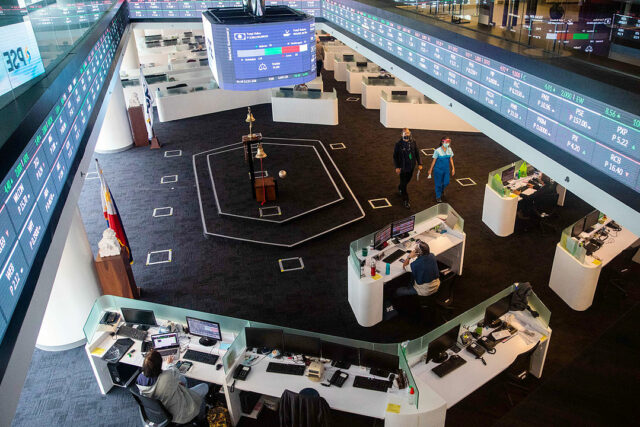Shares seen to move sideways on record-low peso

LOCAL STOCKS may move sideways this week on the lingering effects of the interest rate hikes by the US Federal Reserve and the Bangko Sentral ng Pilipinas (BSP) amid the depreciating peso.
The bellwether Philippine Stock Exchange index (PSEi) slipped by 42.17 points or 0.66% to close at 6,259.54 on Friday, while the broader all shares index went down by 14.95 points or 0.44% to 3,341.29.
Week on week, the PSEi declined by 289.23 points or 4.42% from its close of 6,548.77 on Sept. 16.
“Selling marked this week’s trades, given the Fed’s 75 basis points (bps) and BSP’s 50-bp rate hike adjustment,” online brokerage 2TradeAsia.com said in a report.
In a Viber message, Salisbury Securities Corp. Equity Sales Trader JP Dela Cruz said the market was down again “due to the more hawkish stance of the Fed” while the Philippine market is expecting the BSP “to continue hiking rates in line with the Fed to protect the peso and slow down inflation.”
Last week, the Fed raised its monetary policy rate by 75 bps for a third time, bringing the Fed’s cumulative hikes for this year to 300 bps.
Meanwhile, the BSP raised benchmark rates by 50 bps for a second straight meeting to bring the hike in borrowing costs to a total of 225 bps since May.
For the week, Salisbury Securities’ Mr. Dela Cruz said that the PSEi “has more room to go down.”
“[However,] we remain bullish and investors or traders should take advantage of these dips going into the fourth quarter of 2022,” he added.
Meanwhile, Philstocks Financial, Inc. Senior Research Analyst Japhet Louis O. Tantiangco said that “trading may remain tepid as the market continues to move without a positive catalyst.”
“We do not expect a significant rally from the market yet as it is seen to continue dealing with expectations of further policy rate hikes by the Federal Reserve and the Bangko Sentral ng Pilipinas,” Mr. Tantiangco said.
He added that the Philippine peso, which is now below the P58-per-US-dollar level, “is also expected to continue weighing on sentiment.”
On Friday, the local unit closed at P58.50 versus the greenback from its P58.49 finish on Thursday, data from the Bankers Association of the Philippines showed.
Year to date, the peso has weakened by 14.7% or P7.49 from its P51-close in the previous year.
“For now, a defensive portfolio with strong balance sheets should be able to weather the brunt of weak currency, higher cost of debt, and generally volatile inputs market,” 2TradeAsia.com said. It placed the PSEi’s immediate support at 6,000 and resistance at 6,400.
Philstocks Financial’s Mr. Tantiangco put the PSEi’s immediate support at 6,200, key support between the 6,000 and 6,100 range, and resistance at the 6,400 level.
Salisbury Securities’ Mr. Dela Cruz placed the index’s support at 6,000 and resistance at 6,300. — Justine Irish D. Tabile
